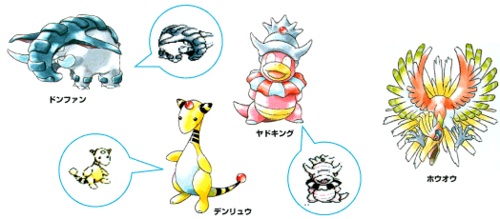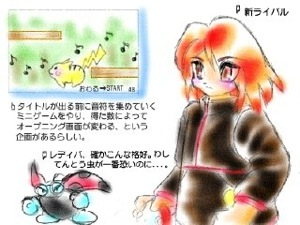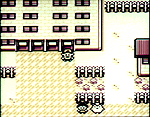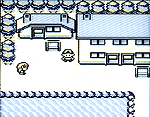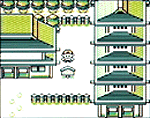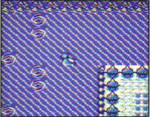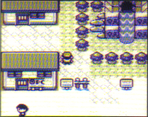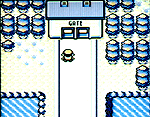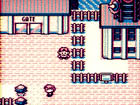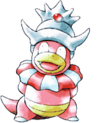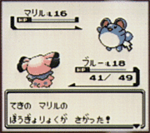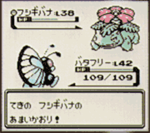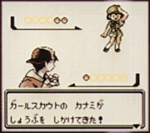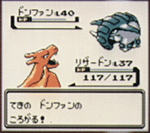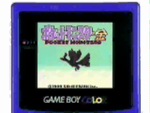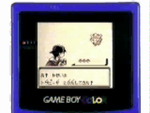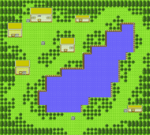Pokémon Gold and Silver beta: Difference between revisions
Yamiidenryuu (talk | contribs) (→First screenshots: Moving this to the talk page for now.) |
|||
| Line 108: | Line 108: | ||
The battle system, nearly complete, was demonstrated, including wild Pokémon encounters. The new [[Pokédex]], while close to completion, was still missing several features, such as the [[footprint]] and [[National Pokédex]] number of the Pokémon. The "location", "[[cry]]", and "print" functions were also missing. | The battle system, nearly complete, was demonstrated, including wild Pokémon encounters. The new [[Pokédex]], while close to completion, was still missing several features, such as the [[footprint]] and [[National Pokédex]] number of the Pokémon. The "location", "[[cry]]", and "print" functions were also missing. | ||
The images released look very similar to the images that appear in the final versions of the games. The locations shown | The images released look very similar to the images that appear in the final versions of the games. The locations shown do no't appear to be part of the final map, though they look similar. | ||
{| align="center" style="{{roundy|20px}} border: 2px solid #{{gold color dark}}; background: #{{gold color}};" | {| align="center" style="{{roundy|20px}} border: 2px solid #{{gold color dark}}; background: #{{gold color}};" | ||
Revision as of 19:44, 23 December 2012
| The original logo of Pocket Monsters 2 |
The development cycle of Pokémon Gold and Silver, released in 1999 in Japan and 2000 elsewhere, is probably the most discussed and researched of all releases of Pokémon games in the history of the franchise. A relatively broad amount of official material in combination with later investigations reveal a lot of details about incomplete and unreleased elements. Several aspects from their prototype versions are proof of the over two year development period Game Freak undertook with the sequels of the Generation I games.
First mention of Pocket Monsters 2
In 1997, Nintendo announced the first details of the next generation of Pocket Monsters games, to be titled Pocket Monsters 2: Gold and Silver. The games were intended to be released at the end of the year for both Game Boy and Super Game Boy.
One of the many additions promised, notably, was a skateboard that could be used in addition to the Bicycle of the previous games and would allow users to travel to "unusual places". Though this never made the final cut, other things announced, such as the real-time clock, 100 new Pokémon, including new evolutions of old Pokémon, new TMs and HMs containing new moves were included. The trading and communication abilities of the games were also to be improved, and backward compatibility with the Generation I games was also announced.
| A 1997 edition of MicroGroup Game Review, the cover featuring prototype Pokémon and characters that were part of the development of the first Generation II releases | Four "new" Pokémon that would be included in Pocket Monsters 2: Donphan, Ampharos, Slowking, and Ho-Oh. Due to the color palette used in the sprites, these were likely released after the games' development was focused to include Game Boy Color-exclusive enhancements | Concept art depicting Ledyba, Silver, and the introductory cutscene from Gold and Silver |
New Pokémon in the anime
The anime also provided early looks at the new Pokémon. Ho-Oh, the eventual version mascot of Pokémon Gold, appeared in the first episode. Later, Togepi hatched from an Egg Ash himself found, and Misty became the first main character to own a Generation II Pokémon. Snubbull and Marill made their first appearances in Pikachu's Vacation, and Donphan appeared at the start of Mewtwo Strikes Back. During the second season, Ash and Misty also encountered Tracey, who owned a Marill; Lugia, the version mascot of Pokémon Silver, was the focus of the second movie, in which Slowking also appeared. Bellossom, Ledyba, Hoothoot, and Elekid also made an appearance in Pikachu's Rescue Adventure.
First screenshots
The color scheme in these screenshots was not as varied as the one provided by the Game Boy Color. Instead, the colorscheme of these screenshots indicates that the games initially used a palette-changing feature that was present on the Super Game Boy (as well as the Pokémon Stadium series games and Pokémon Yellow), with different areas being colored differently (such as Pewter City having a gray palette, Cerulean City having a blue palette, and so on).
At this time, the early game screenshots released generally didn't look all that much different from Generation I. The pictures clearly show the games' engine being in a more developed but still early stage. The lack of battle images would seem to indicate that a redone battle system had not been implemented yet.
| Coming out of a building | Silent Hills (Japanese: サイレントヒルズ), the originally planned starting town |
This town was ultimately either changed into Ecruteak City (perhaps with the Tin Tower at right) or removed altogether | The same location from a different build of the game, with some map elements altered and the trees more closely resembling those used in the final version |
| Whirlpools were originally randomly interspersed across sea routes to serve as obstacles. | An early design for the Pokémon Center. An Unown ruin can be seen in the upper-right corner of the picture. | A simplified version of Johto Route 35 and National Park's entrance, except with water instead of trees and fences and no open path to the right | A possible early design for the Goldenrod Radio Tower can be seen on the right-hand side of this screenshot |
Pocket Monsters Gold and Silver announced
| The second logo of Pocket Monsters Gold and Silver, with the number 2 being dropped from the title |
The end of 1997 passed without a release for Pocket Monsters 2: Gold and Silver. The potential release date was removed, and things generally stayed quiet until early 1998.
It was at this time that the games were reannounced as Pocket Monsters Gold and Silver. Though the "2" was dropped, the games remained essentially a sequel to Generation I. Much of the year was quiet with regard to information about the games, as Pocket Monsters: Pikachu was on its way out in Japan, and Pokémon Red and Blue and the Pokémon anime were on their way to the United States.
New information emerges
| The final logos of Pocket Monsters Gold and Silver |
Following nearly a year without press releases, the Nintendo site was finally updated with new information on Pocket Monsters Gold and Silver. A revised release date of June 1999 was given and it was announced the games would be compatible with the then soon-to-be-released Game Boy Color.
Ken Sugimori's artwork for Slowking, Marill, Bellossom, and Hoothoot was also released, as were several screens of the new battle system featuring fully colored sprites.
The battle screens are very similar to the final ones; however, the absence of gender notation is apparent. Pokémon gender was a previously announced feature, and the display of gender during battle was likely added later as a convenience to players.
The attack stats window, which in the final version tells players the remaining and total PP of each move, as well as its type, was apparently not fully completed at this point in development.
The battle system, nearly complete, was demonstrated, including wild Pokémon encounters. The new Pokédex, while close to completion, was still missing several features, such as the footprint and National Pokédex number of the Pokémon. The "location", "cry", and "print" functions were also missing.
The images released look very similar to the images that appear in the final versions of the games. The locations shown do no't appear to be part of the final map, though they look similar.
| Artwork of Slowking | Artwork of Marill | Artwork of Bellossom | Artwork of Hoothoot | Snubbull vs. Marill | Butterfree vs. Venusaur |
| Player vs. Picnicker Kim on Johto Route 35 |
Charizard vs. Donphan | The prototype title screen of Pokémon Gold, reminiscent of those of Red, Green, and Blue | A near final title screen for Gold | "Ah! A wild Togepi appeared!" | "Now investigating this newly discovered Pokémon." |
Postrelease discoveries
Leftovers
| "When my Pokémon got sick, the pharmacist in Ecruteak made some medicine for me." |
Since Pokémon Gold and Silver were released, other things have been uncovered that reveal interesting details about the games' development. The final games have a large number of incomplete maps that detail what most Johto towns looked like during development. One of the most complete prototype maps found in their programming is a rough version of the Safari Zone. Surprisingly, it has several of its attributes defined, such as music, connections to Fuchsia City and even wild Pokémon found by fishing in a small pool in the area, which other prototype maps do not have. The Safari Zone also appears in the internal list of Pokégear map locations, along with Viridian Forest, Cerulean Cave, and Pokémon Mansion. Another complete map is a house in Olivine City, where a woman refers to a pharmacy in Ecruteak City instead of Cianwood City. It is unknown if this is a typo made by the game designers or if this means the Cianwood Pharmacy was originally meant to appear in Ecruteak.
Full maps (minus events) exist for the Cinnabar Island Lab, indicating Cinnabar Island was originally to make an appearance without the erupted volcano, or at least that the lab was going to remain. Apart from maps, other uncovered elements include a mine cart image in the cave tileset, and a second card-flipping Game Corner game. There is also an unused event script, complete with text, which would allow a different event for a level 40 Entei, analogous to the birds in Generation I.
In addition, the games include large amounts of unreferenced text. For example, one block of text references the fact that Sweet Honey, which made its debut in Generation IV, was planned as early as Generation II. Code and text remain for yet another forgotten feature, the ability to name the player's mother. Space is reserved in RAM for two other names as well, which default to RED and GREEN — the player character and rival from Red and Blue.
The Bird type from Generation I remains in Generation II. This is presumed to be a carryover from the Generation I game engine, as Gold and Silver are based on it. Also returning from leftover Generation I code are the Town Map and Poké Flute items. Both are named "Teru-sama" and are unusable, but if hacked to have a use option, the Poké Flute will still function, and the Town Map will attempt to, but fail, as the data it would access is now in a different location.
There is unused battle data for Cal, the default opponent in the Trainer House. There are two parties - one with the basic forms of the Johto starters and one with the middle forms of the Johto starters. As Viridian City and therefore Trainer House cannot be legally accessed until late in the game, it is unknown what purpose these parties would have served.
Another beta remnant is an unused sprite. This sprite is that of the player, only not carrying his pack. This sprite may have been originally intended to be used by the Cal event, but was later left in favor of the player's own sprite. This sprite is fully inserted in the game, containing all data of a normal overworld sprite, except it is not used by any known event in the game. It may have been intended as the sprite used at the start of the game (when naming the player character).
There is hidden text for an event related with the Burned Tower, where someone's daughter was missing. It is possible that this event made its final debut as the missing granddaughter in the S.S. Aqua.
Beta maps
Beta maps can be found existing in the final game's code. They appear to be a version between the ones presented originally, and the ones that were final.
| New Bark Town's beta map | Cherrygrove City's beta map | Violet City's beta map | A beta map of a town, possibly Azalea |
Ecruteak City's beta map, showing the Magnet Train tracks |
| Olivine City's beta map | A prototype Lake of Rage, with the incorporated Gym | A possible beta map of Blackthorn City |
The beta Safari Zone, which uses the Generation II evolution music as the background theme | Beta map of Kanto Route 23 |
External links
- Glitch City Safari Zone
- Pokémon GS Pre-Release Images (Wayback archive)
- IGN Pocket
- Pokémon GS prototype Information
- Pkmn.co.uk Lost Pokémon!
- Pkmn.co.uk GS prototype Maps
- Tohjo Falls Crystal Text Dump
- Pokefor.tk Pokémon GS Pre-Release (Wayback archive)
- Pocket Monsters 2 Alpha Release Information (Wayback archive)
- Beta Song
- Ecruteak Daughter

|
This game-related article is part of Project Games, a Bulbapedia project that aims to write comprehensive articles on the Pokémon games. |


